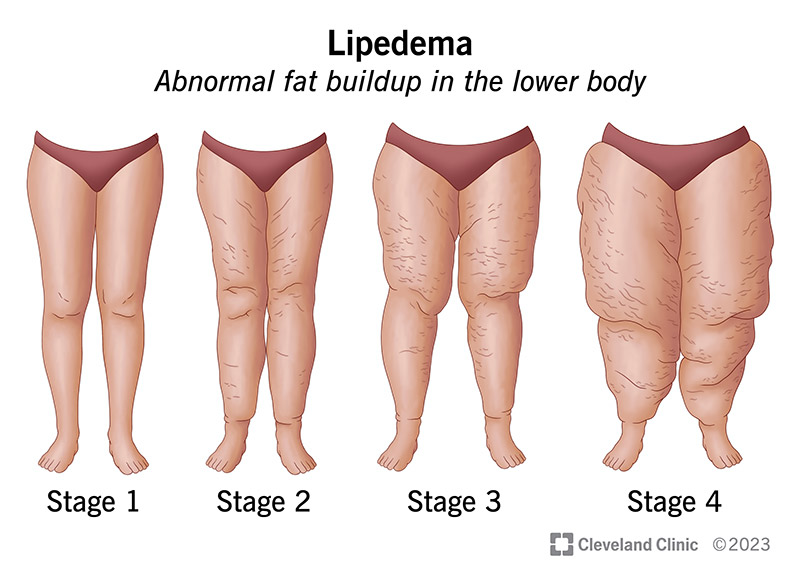Lipedema & Lymphedema Support
Lipedema & Lymphedema Support
Non-invasive management of lipedema and lymphedema
Lezlie Cebulski, traditional naturopath is an experienced practitioner who can advise and provide supportive treatments to slow the progression of lipedema and lymphedema. Unmanaged Lipedema usually gets progressively worse. Lipedema can eventually cause lymphedema, which can be disabling. It is important to be proactive managing Lipedema and Lymphedema! It often starts in the teen years and can worsen during the onset of perimenopause and menopause.
She advises and teaches non-invasive management of lipedema and lymphedema with:
- anti-inflammatory diet education
- lymphatic exercises
- compression types and uses to slow progression and maintain comfort
- skin care helpful for lipedema and lymphedema
- lymphatic pumps
- dietary supplements helpful for lipedema and lymphedema
- GLP-1 antagonist telehealth resources and its benefits
- recommendations of vascular surgeons in Metro Detroit and lymphatic massage therapists
She uses her personal experience on the topic, along with her educational training, and tools in her holistic healing office for non-invasive, non-medical treatment such as:
- lymphatic pumps
- red light therapy
- infared sauna
- color therapy
- muscle testing on anti-inflammatory dietary supplements
She has recently developed a essential oil blend / massage oil, X-Inflamm Triple Action which helps reduce pain, inflammation and maintain fluid balance.
Contact Lezlie Cebulski for an in-person or online appointment.
Lipedema and Lymphedema often go undiagnosed and will progressively worsen in most people. It is estimated that 1 out of 10 women have Lipedema, which is a type of connective tissue disorder. Lymphedema can be caused by Lipedema.
You may have Lipedema if you experience:
- a person’s sex — lipedema occurs almost exclusively in females
- symmetrical fat deposits on both legs
- minimal fat deposits on the hands and feet, which creates a cuff-like appearance
- pain and tenderness on touch
- a feeling of heaviness and tension in the affected limbs
- symptoms that worsen over the day
- cool skin
- easy bruising
- disproportionate swelling of the affected limbs even when a person loses weight
- minimal pitting edema
- telangiectasias — small, broken blood vessels on the surface of the skin around the fat deposits
Types of Lipedema
- Type I: The fat is between the navel and the hips. It often covers the pelvis and buttocks.

- Type II: The fat is around the pelvis and down to the knees.
- Type III: The fat begins at the pelvis and continues down to the ankles. A person with this stage may have a prominent cuff of fat at the ankle.
- Type IV: The fat spreads from the shoulders down to the wrists.
- Type V: The fat is predominantly on the calves.
Some people have a combination of types, commonly Type II and IV or Type III and IV. Type V is very rare.
Lipedema is a condition that develops over time. Do not delay proactively managing Lipedema.
There are four stages of lipedema:
Stage 1
- A person’s skin appears normal and is smooth to touch.
- The person will have nodules of enlarged fat present underneath the skin.
- A medical professional can feel these nodules during an examination. A person with stage 1 lipedema may experience some pain and easy bruising.
Stage 2
- The surface of a person’s skin becomes uneven. The skin may become dimpled, have indentations, and develop mattress-like patterns.
- The amount of fat will also increase in stage 2 compared with stage 1.
Stage 3
- A person may develop large extensions of skin and fat. These visible, large folds of skin and fat can protrude from the limbs. This can cause the legs to appear columnar.
- These protrusions of fat can put pressure on a person’s joints and may affect their mobility and balance.
- These protrusions develop due to inflammation and the thickening of tissues in the limbs. This causes a loss of elasticity, leading to reduced blood flow and lymph flow out of the fatty tissue, causing it to grow.
Stage 4
- This stage is when lipedema and lymphedema are present in the body.
- Lymphedema is the buildup of fluid in the body’s tissues due to a damaged lymphatic system.
- Lymphedema develops when lipedema causes the buildup of fat cells to interfere with a person’s lymphatic system.
Contact Lezlie Cebulski for an in-person or online appointment.
